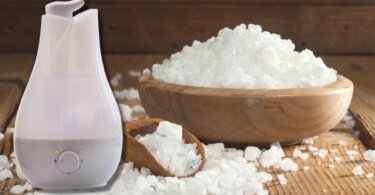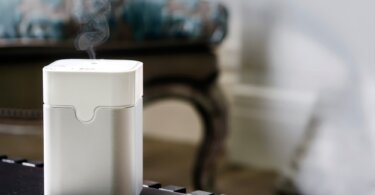To understand what leads to low humidity in a house, you first need to know what humidity is. And why it’s such a hot topic of discussion for many homeowners.
Humidity is nothing but the amount of water vapor that exists in the air. And as you guessed, low humidity is the condition where the water vapor level drops dangerously low.
Now that may not seem to be too much of a problem. However, moisture is essential for healthy living.
But it has to be the right amount because too much or too little of it can trigger health problems. Here’s more about what causes low humidity in a house and its consequences.

What Causes Low Humidity Indoors
During winter, the humidity levels usually drop, and the air loses moisture and becomes dry. Low humidity, or low relative humidity, is the amount of water in the air compared to the total amount it can contain at a specific temperature.
So 90% of relative humidity in summer leaves you sweaty. However, the same 90% of relative humidity in winter leads to air that’s much dryer than it usually is.
Heating and Cooling Systems
Heating and cooling systems regulate indoor temperatures and make your life more comfortable. However, these systems can also affect indoor humidity levels. In general, heating systems tend to reduce humidity, while cooling systems can increase it. This is because both systems remove moisture from the air as they operate. As a result, if indoor humidity levels are already low, running a heating or cooling system can further contribute to the problem.
On the flip side, specific cooling systems, such as evaporative coolers, can add moisture to the air. If not properly maintained, these systems can cause indoor humidity levels to become too high. You should know how your home’s heating and cooling system can affect indoor humidity levels and take steps to maintain a healthy balance.
Poor Indoor Ventilation
Your home’s ventilation system is responsible for circulating fresh air throughout the house. However, if the ventilation system is not working properly, it can contribute to low indoor humidity. Stale, stagnant air will not only feel stuffy and unpleasant, but it can also lead to the growth of mold and mildew.
In addition, poorly ventilated homes are more likely to experience condensation on windows and walls, as well as musty odors. Therefore, it’s vital to ensure that your home’s ventilation system is up to par to maintain healthy indoor air quality. Otherwise, you may be inadvertently contributing to low indoor humidity levels.
Excess Indoor Moisture
Excess moisture in the home can lead to several problems, including low indoor humidity. When there is too much moisture in the air, it can cause condensation to form on surfaces, including walls, floors, and windows. This condensation can lead to mold and mildew growth, further contributing to low indoor humidity levels.
In addition, excess moisture can also cause wood floors and furniture to warp and crack. To help prevent these problems, it is important to keep the level of humidity in your home within the recommended range of 30-50%. You can do this by using a humidifier or by opening windows and doors on days when the outside air is not too dry.
Extreme External Weather Conditions
Low indoor humidity can be a severe problem, leading to health conditions such as respiratory infections, nosebleeds, and static electricity shocks. It can also damage wood furniture, flooring, electronics, and musical instruments. A leading and persistent factor of low humidity is extreme external weather. Cold weather causes the air to hold less moisture, leading to indoor humidity levels dropping below 30%.
In addition, hot weather can cause moisture to evaporate, further decreasing indoor humidity. Windy conditions can also contribute to low indoor humidity by increasing the evaporation rate. Maintaining healthy indoor humidity levels can help protect your family’s health and your home’s belongings.
What Is The Ideal Indoor Humidity Level?
When you speak about good indoor humidity levels, it has to be the healthiest range of relative humidity for humans to live in. It’s described as ‘ range’ because there are so many factors determining it.
The exact level depends on factors like temperature, season, and climate zone.
According to the environmental protection agency (EPA), it is always better to maintain below 60% indoor relative humidity. While this is the threshold, the ideal range spans between 40-50%, with the lowest being 30% and the highest below 60%.
This range also largely depends on the temperature.
Symptoms Of Low Humidity Levels In The House
After learning the causes of low humidity at home, you should know its consequences. It’s because low relative humidity can lead to poor health conditions like dry and itchy skin and red, sore, irritated, and itchy eyes.
1. Poor Sinus Health
It’s also very common to find people living in low humidity suffering from poor sinus health. Their sinus ends up very dry due to reduced atmospheric moisture and more susceptible to various diseases and allergens.
2. Inflamed Respiratory Tract Membrane Lining
Besides, the low moisture can, with time, inflame the respiratory tract membrane lining. As this is a sensitive membrane, the inflammation leads to more problems while increasing the chances of infections like a cold or flu.
What’s worse, the reduced humidity helps the flu virus survive longer and spread faster.
3. Low Humidity Headache
Don’t worry if you suffer from frequent headaches. According to the World Health Organization (WHO), headaches are the most common nervous system disorder and about 50% of adults experience it at least once a year.
However, did you know that low humidity could be a potential cause for it?
Yes, while stress tops the chart in factors responsible for causing headaches, low humidity is also another cause.
Low humidity can lead to nervous disruption, and its prolonged exposure can result in headaches. The headache starts with nasal dryness, where the mucus membrane dries out. It soon develops cracks and reaches a point where it also gets irritated and inflamed.
Due to the inflammation, it’s difficult for blood to flow at the standard rate through the sinus cavities. In turn, it triggers a pounding headache.
Low humidity can also trigger headaches by promoting the existence of repulsive chemicals in the atmosphere. Here’s how it happens.
Everyday household items like paints, new materials, and furniture contain toxic residues of the chemicals used in the manufacturing process.
These chemical molecules usually end up trapped on the surfaces. The low humidity leads to the evaporation of these toxic residual chemicals into gaseous form and the air.
The human body ends up easily breathing and inhaling these chemicals. Regular inhaling of these chemicals can lead to headaches and other health problems.
Effects On Your Home
Low humidity also takes its toll on your home and structure. It sucks up any available moisture found in your woods and cracks and therefore splinters and shrinks wood.
For example, it damages anything made of wood like your floors and furniture. The damage is not only irreversible but expensive to repair or replace.
Besides, your paint and wallpaper dry out, leading to peeling and chipping.
And most importantly, dry air is the perfect atmosphere for static electricity. So don’t be surprised if you experience a slight jolt whenever you touch a roommate or something like the doorknob or any fabric.
How To Fix Low Humidity In My House?
The good news is that you can improve your home’s humidity levels by:
1. Showering With The Door Open
Leaving the shower door open to introduce moisture into the atmosphere. If you use a hot bath, letting the water stand for a while increases humidity.
But be careful with both options if you have small children or pets around.
2. Boiling Water
You can manually introduce moisture into the air by boiling water on the stove and your slow cooker. Of course, they only provide short-term solutions and are not ideal for the long run.
3. Drink Tea Instead Of Coffee
Drinking tea instead of coffee helps because the extra steam while brewing helps moisten your facial skin.
4. Indoor Drying of Clothes
Hang your clothes indoors where possible instead of using the dryer. It not only increases your home humidity levels but also helps reduce your electricity bill.
5. Have Some Houseplants
Houseplants help because they release moisture from their leaves and stem into the atmosphere as long as you take good care of them.
6. Leave Water Bowls
Leaving water bowls around the house also helps. The water evaporates to increase your atmospheric moisture levels.
7. Invest In a Humidifier
The best solution to the problem of low relative humidity is using a humidifier. Humidifiers help by breaking down water into tiny droplets or mist using wick filters flown by a fan or ultrasonic vibrations.
As humidifiers come in various types, capacities, sizes, and kinds, you can’t buy just any humidifier for your home. You need to invest in a humidifier ideal for your specific needs and home conditions.
And there are many factors to consider, like mist output capacity, room size, and tank size, to make a choice.
Related articles:
5 Best Humidifiers for 1,000 Square Feet
The Best Humidifiers for Hard Water Without White Dust
Do I Need A Wardrobe Dehumidifier
FAQs
Does Low Humidity Make You Sick?
Some people are more susceptible to illnesses when the air is dry, although the direct impact of low humidity on getting sick remains unknown. One proposed mechanism is that virions (infectious particles) become airborne more easily and stay viable in low humidity conditions.
Low humidity could also increase susceptibility due to drying out of mucous membranes, making it easier for virions to penetrate. An accompanying decrease in ciliary action (tiny hairlike projections that help remove bacteria and debris from the lungs) could further contribute to an increased susceptibility to infection.
What is a Dangerously Low Humidity Level?
20% and below humidity levels are dangerously low. These low indoor humidity levels can occur when the air is very dry, typically during winter. The low humidity can cause serious health problems, particularly for those with respiratory conditions. Dangerously low indoor humidity symptoms include:
- Irritated eyes, nose, and throat.
- Coughing and wheezing.
- Difficulty breathing.
- Increased risk of viral infections.
Low humidity can also cause furniture and wood floors to crack and split. If you suspect your indoor humidity levels are dangerously low, increasing the moisture in the air is vital. You can do this by using a humidifier or simply keeping a pot of water boiling on the stovetop.
What is the Best Room Humidity for Sleeping?
According to most experts, the ideal humidity level for comfortable sleep is between 30 and 50 percent. This humidity range allows the skin to stay hydrated while preventing mold and mildew growth.
Some people find that a slightly higher or lower humidity level is more comfortable, so it’s important to experiment to find what works best for you. Additionally, keep an eye on the indoor humidity levels in your home during cold weather, as lower outdoor temperatures can cause indoor air to become dry and uncomfortable.
Conclusion
In short, you shouldn’t take low humidity lightly.
It can cause poor health conditions and damage your home structure. You have to work at improving your home’s relative humidity levels with the topmost priority.
As mentioned earlier, the healthy humidity range is around 40-50%. While a slight increase or decrease is permissible, humidity levels should never fall below 30%.
A lower than 30% humidity level means the air is dehydrated, triggering various health problems.





Leave a Comment